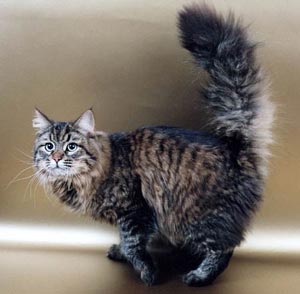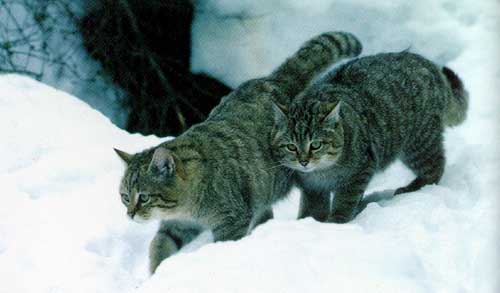

Siberian Breed Standard

History: native breed occurred in Siberia and Far East of Russia. Siberian cats are well-known in Russia more than 200 years. First standard was established on 1989 (proposed by O. Mironova).
General: strong, massive, muscular, powerful animals from medium to large size. Females are generally smaller in size than males. Coat is medium long, dense, with well-defined guard hair.
Head: large, shaped as short broad trapezium, in good proportion to the body, with the slight flat plane on the top of the head. The profile is without stop with smooth dip from the short forehead to the broad straight nose. The nose is medium long. Cheekbones, whisker pads and chin form a smooth, rounded line. Chin is wide, rather strong, but not protruding. Neck is strong and short.
Ears: medium size, wide at the base, the distance between the ears exceeds the width of one ear at the base. The external earline is vertical, the external end of the earbase is slightly above the eyelevel. The ears are slightly tilted forward, tips are rounded. Finishing the ears by tufts and brushes is preferred.
Eyes: medium size, rounded, set wide apart, with the outer corners tilted slightly upward. Color is green or yellow of various gradations, distributed evenly. The eyes of the cats îf pointed and white colors are bright blue. The cats of "van" and white colors may have oddly colored eyes.
Body: medium length, massive, with well-developed muscles, on the strong legs of medium length. Hind legs are slightly longer. Paws are large and round. Hair tufts between the toes are strongly desired.
Tail: medium length, thicker at the base, slightly tapering to the tip.
Coat: medium long. Guard hairs are solid, glossy. On the torso sides, the fur is softer, lightly-lying, and very dense. Undercoat is double, but its grade of expressiveness depends on the season. The decorative fur is long, dense, forms complete ruff and frill. The tail is excellently furnished with fur, the fur forms fluffy "britches" at the hind legs. During the fading season the decorative coat is usually scarce. "Agouty" and "tabby" colors have the most typical coat texture.
Colors: all colors are permitted with the exception of chocolate, lilac, burmese, abyssinian and their colorpoint varieties. "Colorpoint" and "colorpoint with white" Siberians are known as "Neva Masquerade". The expertise is done separately, as per colors.
Condition: cat is healthy, strong, well groomed.
Faults: straight profile; deviation toward the "persian" type; long, narrow, light head and/or face; flat cheeks, weak cheek-bones and chin. Small, rounded, deeply set eyes; large or narrow set ears, straight or high set ears, "persian" type ears (small, low-set, too trimmed with fur). Too short, too long, or too lightly built body; weak bones; small paws; no fur tufts between the toes. Slim long neck. Too short and/or sharp tail with a scarce fur trimming. Fur lacking undercoat, extremely tough or fluffy coat, dim on the back and croup.
Disqualify: clearly expressed signs of "persian" type.
Outcrosses with other breeds are not allowed.
| Point score: |
| Head (including ears shape and set) | 25 |
| Eyes | 10 |
| Type (body, Legs and paws) | 30 |
| Tail | 10 |
| Coat (texture and color) | 20 |
| Condition | 5 |
| Condition | 100 |

Siberian Cat, an Overview.
It is hardly disputable that Russian semi-longhair cats have ancient origins. For many tens of years, and probably for centuries, these cats populated Russia and received their now well-known name, Siberians long ago. This common name given to strong and intelligent cat with semi-longhair coat and dense triple undercoat underscores the ability of the animal to survive during cold winters in such areas as Siberia and Northern Russia.
Despite the name “Siberian”, it is unlikely, that the breed truly originated in Siberia. For centuries, Siberia was the country mostly populated with nomad tribes thus providing little opportunity for domestication of wildcats.
There are several hypotheses regarding spread of SLH cats in Russia. The most reconcilable suggests Transcaucasia and Iran as the center of common origin of all SLH and LH cats including Siberian ancestry. Acquisition of long coat and pronounced undercoat by cats lived there is not surprising provided the continental climate in these areas with quite low temperatures in mountainous areas in winter. Indeed, the endemic subspecies of Transcaucasian wildcat (Felis silvestris caucasica) is very similar to a Siberian in appearance.

The road of proto-Siberian cats to their current state was long. It looks likely, that initially SLH cats spread to Middle Asia with merchants during the flourishing of early Moslem states near a millennium ago. Traces of this spread can be found till now since almost forgotten but once famous Bukhara SLH cats are hardly distinguishable from modern Siberians. It is also possible that during those times some cats could enter Kiev Russia, but there is no convincing supporting data on this.
Somehow, from Middle Asia and Iran-transcaucasian regions domestic SLH cats entered Russia several centuries ago. And of course, cats capable of hunting rodents outdoors in winter received due attention of all social groups. Protection of grain supplies during long winter was of course of vital importance. In the Russian fairy tails, a cat is positive yet sometimes sly character.
There were few or no wildcats in most part of Russia during that age. Too long and cold winters, too deep snow and too many larger carnivores such as wolves, foxes, and lynxes created very unfriendly environment to smaller cats. That is why, later additions to the initial genotype of SLH cats in Russia were mainly due to various cats imported from Europe.
It is not known, when the domestic cat population in Siberia has been established. It is however, unlikely that this happened earlier than in XVII century when significant amount of Russian settlers appeared in that areas.
In summary, the history of SLH cats in Russia is several centuries long. During this time, artificial selection occurred towards a cat that is good hunter, capable to survive in winters, and is loyal to its owners. These features can be easily noticed in modern Siberians.
Systematic breeding of Siberian cats started less than 16 years ago. Till now, one can easily see Siberian-type cats in the streets of large cities like Moscow and St Petersburg. These cities gave rise to foundation population of the breed, but some cats from Siberia and Far East also participated in breeding program from the beginning of 90-th. Current programs have strong emphasis towards bringing the cats from these regions as well as from northern part of European Russia into breeding. This is of vital importance for broadening and stabilizing the genepool and for maintaining and improving of once established type of Siberians.
The latter is quite distinct from the type of NFC and MCO cats, two other well-known wild-like SLH breeds. Although medium large to large in size, Siberian cats generally look more compact than either of these breeds. The head is substantially broader and neither triangular, nor rectangular, but trapezoid. The profile is also in stark contrast with the straight one of NFCs and extended muzzle of MCOs. The feet are thick and relatively short, especially comparing to MCO. Body and chest should make an impression of power both in males and in females. The collar, although pronounced, especially in males, should be thick and compact. Too long diffuse collar as well as other decorating fur can be indicative of Persian contamination.
Unique character of Siberians continues to attract people in many countries too the breed. Siberians combine independence and loyalty, heavy muscles and suddenly great leaping ability, solid constitution and surprisingly soft voice that consists of chirps and squeaks rather than commonly known meooooow. The cat frequently answers its owner and can even remember two or three names.
Siberians are great hunters. None of the butterflies, moths, mice, beetles will be left without attention. If the live object absent, a SIB cat can play with toys for long time. Furthermore, the cat will constantly drag the owner into playing. It is very easy to teach a Siberian to fetch. Anything, even a modest piece of fur or paper can be the subject of great game. Siberians require intense playing for disposing of excess energy. Potential SIB owner should consider the fact that it will be necessary to devote considerable time for playing and paying attention to the cat. When interested, Siberians are great problem solvers. They easily remember where a toy was put yesterday; they can take it and ask to play with them by touching you with a paw.
| 






